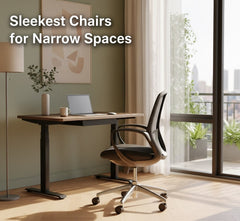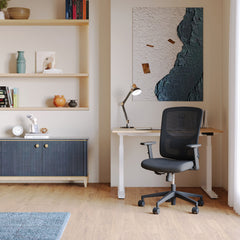Get 10% off your first order
Find the office furniture that’s designed to match your style, comfort, and needs perfectly. Subscribe
Sleekest Chairs for Narrow Spaces

Visit quiz page to see how we makes it easy to create an inspiring workplace


Long hours at a desk can drain both energy and focus. The trick isn’t to work less—it’s to move smarter. Even subtle changes in how you sit, stretch, or shift your posture can refresh the body and recharge your concentration.
Energy doesn’t just come from caffeine or motivation. It comes from motion, balance, and smart design choices that keep your body and mind aligned throughout the workday.
Let’s explore how to turn your workspace into an active zone where productivity meets movement.
The body is designed for motion. When you sit too long, your muscles tighten, your blood flow slows, and your energy drops. Over time, it leads to fatigue and stiffness that make focus harder to maintain.
Afternoon crashes and brain fog
Tension in the neck and lower back
Restless legs or poor posture
Reduced creativity and slower task switching
Even small bursts of movement during work can reverse these effects, helping you stay engaged longer.
The Small Standing Desk Alaska is designed to encourage motion and flexibility. It lets you easily transition between sitting and standing, promoting better circulation and sustained energy.
|
Feature |
Benefit |
|
Adjustable height |
Prevents stiffness |
|
Compact form |
Keeps movement simple |
|
Smooth surface |
Easy posture shifts |
|
Minimal design |
Reduces clutter for motion |
The more adaptable your workspace, the easier it is to stay active throughout the day.
You don’t have to leave your workspace to move your body. Integrating motion into daily tasks can keep your blood flowing and energy up.
Rotate shoulders every 30 minutes.
Shift your weight from one foot to another while standing.
Stretch arms overhead before answering emails.
Roll ankles and flex calves under the desk.
These movements may seem small but they create long-term comfort.
A standing desk gives you options to switch postures seamlessly. The change in elevation not only engages muscles but also helps your brain reset its focus.
Start the day standing for the first 30 minutes.
Alternate between sitting and standing every hour.
Keep feet flat and posture straight.
Use anti-fatigue mats for comfort.
Habitual variation keeps both your body and your attention flexible.
The right office desk supports not just organization but also how your body interacts with your tools. Proper ergonomics reduce muscle fatigue, keeping focus sharp.
|
Element |
Adjustment |
Benefit |
|
Monitor height |
Eye level |
Reduces neck strain |
|
Keyboard placement |
Neutral wrist angle |
Prevents tension |
|
Chair distance |
90° elbow bend |
Promotes comfort |
|
Surface layout |
Clear space zones |
Enhances movement flow |
When posture feels natural, concentration feels effortless.
According to studies on workplace movement and health, alternating between sitting and standing improves blood circulation, reduces joint strain, and boosts cognitive function.
Regular posture changes enhance alertness.
Active work setups lower fatigue levels.
Movement breaks support better decision-making.
Ergonomically aligned work reduces long-term discomfort.
Physical wellness directly influences how well you can think, focus, and create.

Sometimes, the smallest tools make the biggest impact. An ergonomic arm accessory offers flexibility, letting your arms move naturally as you work, reducing shoulder and wrist fatigue.
|
Tool |
Purpose |
Benefit |
|
Arm support |
Maintains balance |
Prevents tension |
|
Adjustable monitor stand |
Promotes movement |
Improves posture |
|
Compact keyboard |
Frees space |
Allows hand mobility |
|
Footrest |
Adds motion |
Encourages leg circulation |
The goal isn’t constant movement—it’s constant ease.
Movement is only part of the equation. Fresh air and natural light play major roles in keeping you alert.
Open windows for airflow.
Keep blinds half-open to control glare.
Use task lighting to maintain visibility.
Add a plant to refresh oxygen levels.
A balanced atmosphere helps sustain long-term motivation.
Even five minutes of intentional movement between tasks can make a difference.
Step outside for sunlight.
Do ten bodyweight squats.
Stretch neck and shoulders gently.
Take slow breaths before returning to work.
These pauses aren’t interruptions—they’re investments in sustained focus.
Cluttered spaces restrict not only your attention but also your range of motion. A clean desk creates physical and mental freedom to move with ease.
|
Area |
Tip |
Result |
|
Desk surface |
Keep only essentials |
Increases space |
|
Cable management |
Use clips or sleeves |
Reduces clutter |
|
Storage |
Rotate items weekly |
Keeps flow natural |
|
Visual field |
Limit decor |
Maintains calm |
Minimalism clears the path for better habits and freer movement.
Movement doesn’t replace rest—it complements it. Alternating between effort and ease prevents burnout.
Stretch before lunch and mid-afternoon.
Schedule short breathing breaks.
Stay hydrated consistently.
Review posture twice a day.
Balanced energy keeps your performance smooth from start to finish.
Microbreaks—pauses under five minutes—can dramatically improve mental clarity and reduce tension. They allow your muscles and mind to reset without interrupting workflow.
|
Type |
Duration |
Purpose |
|
Stretch pause |
2 minutes |
Relieves body tension |
|
Deep-breath reset |
1 minute |
Lowers stress levels |
|
Hydration moment |
3 minutes |
Keeps focus sharp |
|
Quick walk |
4 minutes |
Boosts blood flow |
You don’t need long breaks to recharge. Regular, mindful pauses build endurance for a full day of productivity.
Temperature influences concentration more than most realize. A workspace that’s too warm causes fatigue, while colder environments reduce flexibility.
Keep temperature between 68–72°F for ideal focus.
Use a small desk fan or portable heater for adjustment.
Dress in layers to adapt throughout the day.
Add light materials like cotton or linen for breathable comfort.
When the environment feels just right, your body conserves energy that would otherwise be spent compensating for discomfort.
Consistency keeps energy steady. Creating a small ritual around posture and movement trains your body to stay naturally active.
|
Time |
Action |
Purpose |
|
9:00 AM |
Stand for 20 minutes |
Start energized |
|
10:30 AM |
Shoulder rolls |
Reset tension |
|
12:00 PM |
Short walk before lunch |
Reoxygenate mind |
|
2:30 PM |
Switch to standing again |
Prevent fatigue |
|
4:00 PM |
Desk stretch and breathing |
End focused |
A gentle rhythm of change keeps your body in motion and your mind at ease, no matter how long your workday lasts.

Energy at your desk isn’t about constant activity—it’s about natural rhythm. When your furniture, posture, and routine align, work begins to feel balanced instead of draining.
Movement feeds clarity.
Comfort encourages discipline.
Design shapes motivation.
Small actions add up to lasting vitality.
Your desk isn’t just where you work—it’s where energy begins.

Sleekest Chairs for Narrow Spaces

Mastering the Wood and Metal Fusion in Furniture

Pairing the Perfect Chair with a Dynamic Desk
Get 10% off your first order
Find the office furniture that’s designed to match your style, comfort, and needs perfectly. Subscribe
Leave a comment